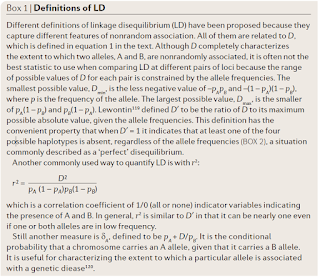Slatkin M. Linkage disequilibrium--understanding the evolutionary past and
mapping the medical future. Nat Rev Genet. 2008 Jun;9(6):477-85. Review. PubMed
PMID: 18427557.
Just in case you don't have access here you have the starting paragraph rant:
Linkage disequilibrium (LD) is one of those unfortunate
terms that does not reveal its meaning. As every
instructor of population genetics knows, the term is a
barrier not an aid to understanding. LD means simply
a nonrandom association of alleles at two or more loci,
and detecting LD does not ensure either linkage or a
lack of equilibrium. The term was first used in 1960 by
Lewontin and Kojima1 and it persists because LD was
initially the concern of population geneticists who were
not picky about terminology as long as the mathematical
definition was clear. At first, there were few data with
which to study LD, and its importance to evolutionary
biology and human genetics was unrecognized outside
of population genetics. However, interest in LD grew
rapidly in the 1980s once the usefulness of LD for gene
mapping became evident and large-scale surveys of
closely linked loci became feasible. By then, the term
was too well established to be replaced.
and some formula:
From wikipedia:






No comments:
Post a Comment